IAnD Exclusive
By Savitha Hira
Photography: Courtesy
Ankon Mitra
The recently
concluded Origami workshop for the NIFT students at Kangra, was a successful
exploration of material behaviour and techniques; to some extent going beyond
the physical realm to touch deeper nuances in design properties, presentation
and the like...
Architect, landscape designer and origami artist, Ankon Mitra has a keen interest in the geometry and
mathematics of plants, trees and flowers.
Through his initiative ‘Oritecture’ he is in continual exploration of
linkages and uses of Origami in Design, Art and Architecture. His strong belief that art should freely
interact and cross-fertilize with other disciplines has seen its most recent
realisation in his workshop with the NIFT students at Kangra.
Exploring issues related to form and structure (both intinsic
to textiles and garment construction) and understanding material translation – a technique that works in paper has
to be adapted to work in fabrics; the texture changes, the methods of assembly
must change – pleats have to be made permanent, paper locks or origami have to
be translated into stitches and button assemblies; the 5-day workshop that had
faculty members participating alongside students, also worked at exposing the
fine line of maths and geometry that is integral in all spheres of design, and
can be used as a tool to understand design process and construction in a
rigorous and holistic way.
IAnD spoke to Ankon Mitra and NIFT faculty
Mr. Asit Bhatt, to get a deeper insight into the exercise and find out the
outcome...
What was the conceptual framework of this
workshop?
Asit Bhatt: The intension was to
inculcate collective and collaborative spirit; where the idea of authorship and
ownership is not marked by individualism. A group of faculty members as well as
students worked in close proximity without having any presupposition of a
hierarchical order whilst transforming the classroom into a playground in order
to encourage peer-to-peer learning. 120 students and about 8 internal faculty
members participated. The module
culminated in an informal fashion-event that was participatory in nature.
What kind of origami techniques did the workshop explore?
Ankon
Mitra: Origami can be (and
usually is) produced from a single sheet of paper, apparel and clothing usually
also from a single or a few different fabric modules, brought together with
stitches and seams. But Origami principles can be adopted/adapted to create
architectural objects and spaces in numerous ways and at different scales. The primary principles
involved are -
- Tessellation: the subdividing of large complex surfaces into smaller, simpler parts that are simpler to comprehend geometrically, and easier to handle and construct.
- Corrugation: the folding of a flat sheet in a way so as to increase its resistance to bending, thereby increasing its capability to span or cover different parts of the body shape effectively.
- Repetition: the duplication of small set of modules in a sequence to create larger assemblies, allowing larger families of geometries to be executed /expressed.
This workshop did not deal with curves or with pleating,
which are vast topics in themselves.
Design thinking is an ongoing process –
did the workshop bring any new revelations in terms of fabric behaviour with a
certain origami pattern or fold and the like?
AM: The workshop revealed
that Origami was surprisingly amenable to textile and apparel applications.
Textiles gain in strength and at the same time certain rigidities, which force
change in behaviour, creating certain flexible shapes, and those shapes guide
how and where those patterns can be applied. For instance, certain forms create
convex shapes better suited for shoulders, upper torso, legs, while other
create concave forms more suited for lower torso, hips, neck and so on. This
forces those using this technique to think about the human body as an
amalgamation of complex geometric forms, all ‘stitched’ together seamlessly by
nature. This in itself is a significant revelation. The body is a work of
geometry, of mathematics. Modifying fabric behaviour and make it semi-rigid or
‘more-defined’ in its behaviour allows this insight to happen.
How did you arrive at the material
palette to be explored?
AM: The focus was on a
set of geometries. There were 12 groups of 10 students each, and each group had
to exhaustively explore all possible permutations and possibilities of that
technique in terms of form and garment construction. The material palette was limited
to simple muslin, crepe, linen and buckram (as a stiffening/foldable material)
that was available locally in Kangra/Dharamshala. Students were encouraged to
dye or paint the fabrics if they felt like exploring colour within their
geometric paradigms; and some did so very
imaginatively and strategically with their patterns.
What are the practical aspects of origami
attire?
- In terms of washing?
- Sitting/sleeping?
- Comfort when worn for long hours?
- Maintenance/ wear and tear?
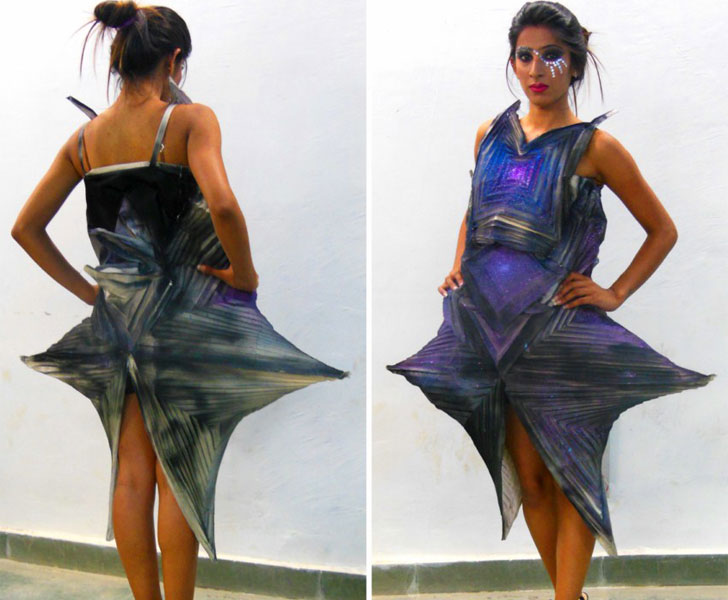 |
| . |
- Often made from single sheets with minimal or no cuts, it means they can collapse into pre-determined folded forms when not ‘opened out’ for usage. Keeping the folds in the more rigid structures can be a challenge sometimes. The more flexible forms keep the folds very well.
- Washing, sleeping and sitting in these garments is again a function of (a) if the garment is rigid/semi-rigid or flexible and (b) material used in the garment construction. Buckram backed and fusing integrated fabrics are reasonably comfortable and can be worn for long hours. The rigid forms made with stiffened polyester or starched silks with hard folded rigid back materials may not be very comfortable and are only good for a few hours of wear to specific occasions/events or parties.
 |
| . |
- Dry-cleaning in neatly folded and collapsed state would be usually recommended. Crushing of patterns and failed attempts to refold are sometimes cited as the reasons origami garments have not become very popular outside of Japan, where it is a part of the culture, which is also very precision driven. These garments have to be taken care of.
- Wear and tear would depend on material again and origami structured garments would usually be hard-wearing because of the inherent strength of the geometric construction; at the same time, some parts of the textile are more exposed than others as the textile is itself 3-dimensional. Thus some parts would fade or show wear, sooner than other parts, the entire fabric would not wear out uniformly.
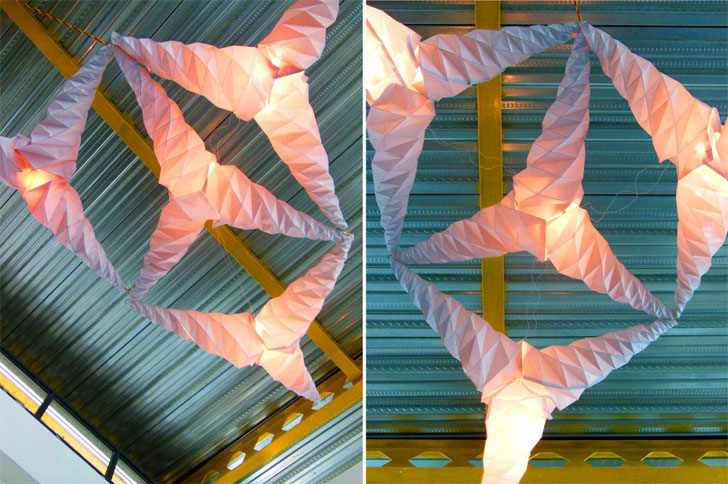 |
| A fabric light fitting |
 |
| Students at work |
Mr. Asit
Bhatt enlightens us that while the copyright of the designs rests with the
respective student groups, NIFT has documented this study for reference. Since
the ideation did not happen through sketches but by appropriating forms
directly on a body, students were equipped with first-hand knowledge of the magic and multi-faceted
nature of Origami applied to fabric to create apparel with specific attributes
like structural lightness, optimization in usage of material, integration with
body structure, easy assembly, inspiring form and modularity etc. With the fundamental building blocks of the
art of folding defined, and with the understanding of their explorations in
various permutations and combinations, the students can now work on larger,
complex geometries.

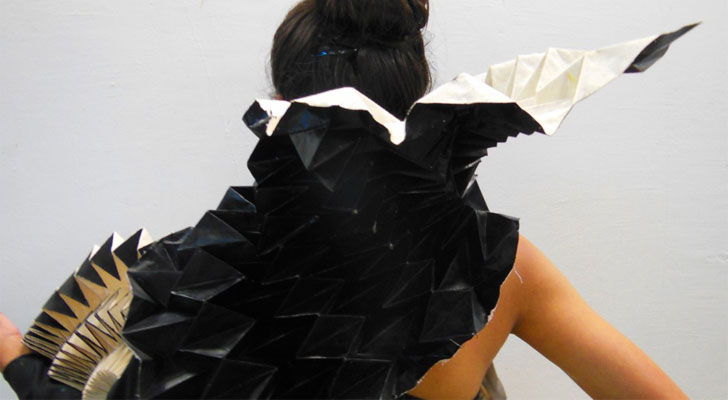
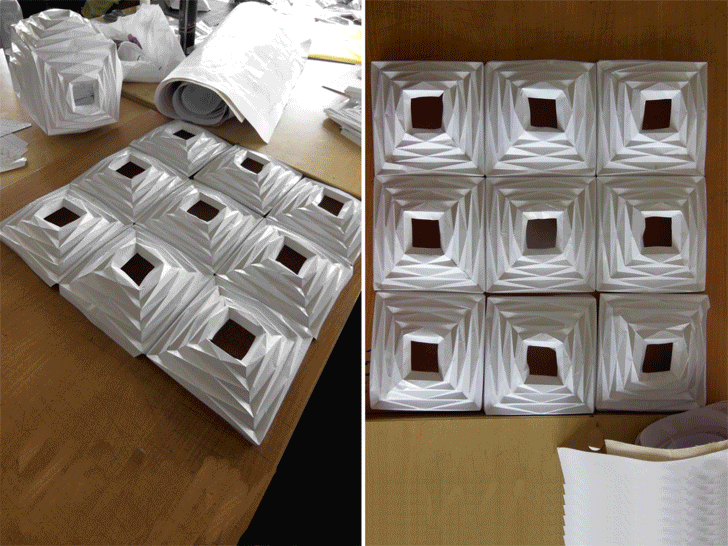

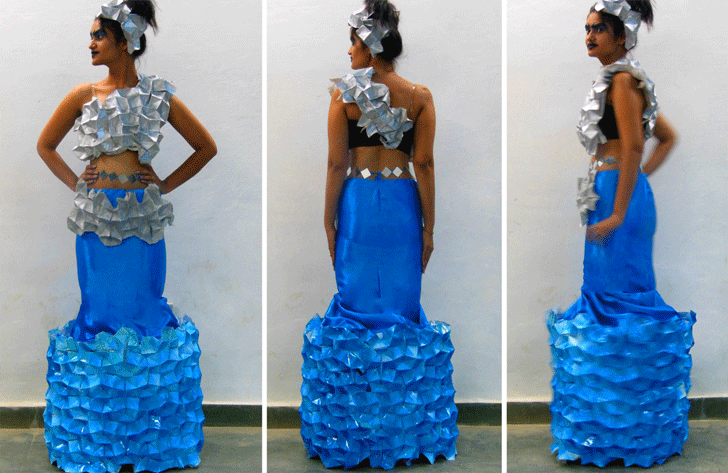

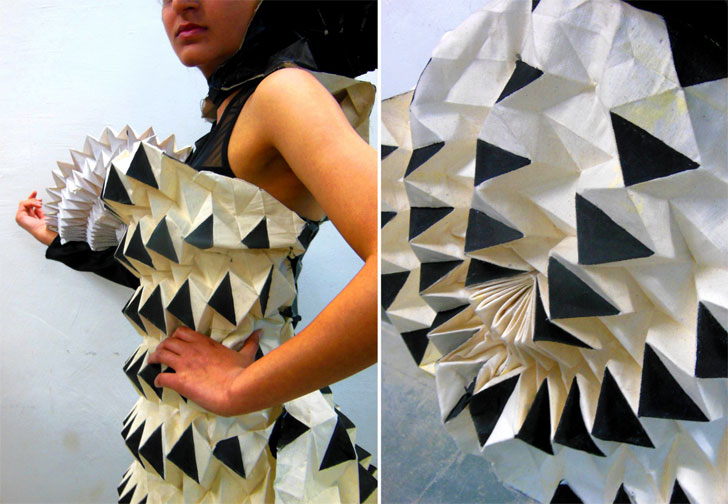
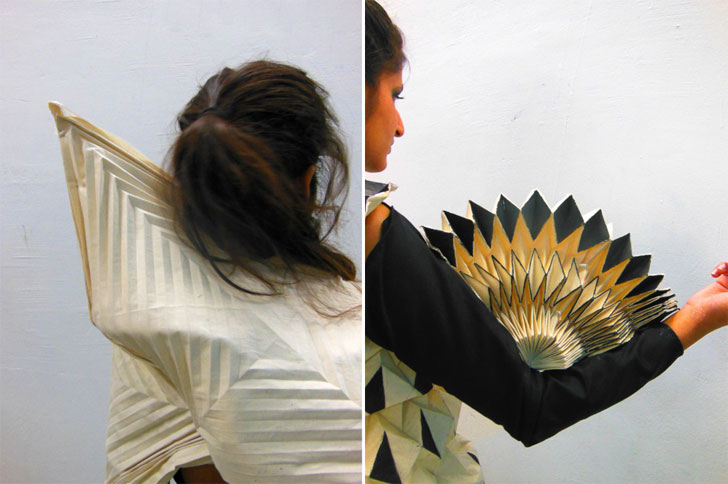
No comments :
Post a Comment